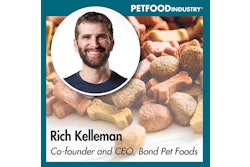
Conventional meat is king in pet food, said Rich Kelleman, cofounder and CEO of Bond Pet Foods. Over 93% of all pet food recipes worldwide include meat and meat byproducts in their recipes. And meat will continue to play a central role in the industry for the foreseeable future, he noted.
“Meat is a beautiful thing for pet health, but its creation comes with a host of environmental challenges to satiate its demand,” said Kelleman. “Additionally, the procurement of meat brings with it an array of supply chain risks related to inconsistent nutritional specifications, shortages and pricing fluctuations.”
Bond Pet Foods is a Boulder, Colorado-based company using biotechnology to create meat proteins that are nutritionally comparable to their conventional counterparts but without all the bad stuff, noted Kelleman. Using some of the same processes that are employed in craft brewing, Bond produces high-quality animal proteins through fermentation, harvests them to better meet the nutritional requirements of companion animals, and supplies the ingredients to manufacturers for pet food, treat and supplement applications.
During his presentation, Protein 2.0: Consumer insights and the path to a more sustainable pet food future, at Petfood Forum on Tuesday, April 30, Kelleman will reveal the results of a new study that uses both quantitative and qualitative fieldwork to help understand the current consensus among pet owners around sustainability concerns, how that influences their brand and purchase decisions, what they know and believe about alternative proteins and what they will accept as viable alternatives in pet food products. Kelleman will also share the prospective impacts these ingredients can have on the supply chain and the environment.
Viable alternative proteins for pet food applications
Several alternatives are surfacing that show promise to produce foundational, high-quality proteins for pet food applications in an environmentally responsible way, noted Kelleman.
Viable alternatives range from more conventional plant-based options, such as potato, soy and peas, to pure microbial proteins, like yeast and mycelium, to insect, including black soldier fly larvae and cricket, to animal proteins produced through precision fermentation as well as cultivated meat.
“Each of these alternatives are at different stages of commercialization, and come with different prospective advantages from a cost, formulary, and positioning standpoint,” said Kelleman. “But all play an important role in providing manufacturers and pet parents with options that can help usher in a more sustainable pet food future.”
Kelleman cautions, however, the familiarity and history of traditional proteins will make these alternatives have to establish their comparative value, going beyond sustainability credentials.
Prospective benefits of these alternatives include social impacts (carbon footprint, animal welfare), nutritional and functional efficacy (essential amino acid quality, bioavailability, palatability) and formulary performance (batch-to-batch consistency, mixability). These create exciting new possibilities for what pet food products can deliver, said Kelleman.
Emerging alternative protein technologies
Emerging technologies in food and ag show promise to mitigate many of the issues surrounding conventional meat procurement and provide manufacturers and pet parents with new ways to deliver high-quality nutrition to their pets.
Two emerging technologies include precision fermentation and cultivated meat. While many people confuse the two as being the same, they are fundamentally different, noted Kelleman.
“Precision fermentation is a technology that employs microorganisms like yeast or fungi to make specific compounds or ingredients such as vanillin, vitamin B12 and enzymes for cheese manufacturing in a more efficient, cost effective and environmentally responsible way,” he explained. “This is Bond’s method of production – we’re just reassembling the decades-old process to produce animal proteins like chicken, turkey and fish that can serve as the foundation of any pet food recipe.”
In contrast, cultivated meat is a much newer technology in the food world, producing meat products from animal cells in vitro, said Kelleman.
“Cultivated meat exhibits a tremendous amount of potential to provide valuable ingredients for the human and pet food industries,” said Kelleman. “But because it’s relatively nascent companies working with it, they have to more fully develop its processes and infrastructure to consistently and economically produce at volume and scale.”
Pain points on the path to market
The challenges to bring alternative protein ingredients to market, while achievable, aren’t insignificant, said Kelleman. Some challenges include communicating their propositions and benefits in a way that’s culturally satisfying – and working through first-to-market activities (depending on the protein) related to production/scale-up, COGs and regulatory requirements.
On the development curve, insect, cultured and fermented protein offerings are still largely in their infancy, said Kelleman. A significant amount of work has yet to be advanced in several areas, including regulations, longitudinal feeding studies, high-volume industrial production, and consumer/market positioning.
“While development challenges are often tied to their corresponding technologies, similar pain points exist on the path to market,” explained Kelleman. ““The ultimate success of these technologies goes beyond solving for foundational regulatory, R&D and scale-up processes. Getting the world to embrace new ingredient and food concepts will also be critical to their success.”
Despite the challenges ahead, Kelleman is hopeful alternative technologies and proteins will carve a brighter future path for the pet food industry.
“My hope is that more companies leading the way in alt protein, whenever possible, share more on what they’re learning and there’s greater collaboration with global manufacturers leveraging their expertise to accelerate a better pet food future,” he said.
Bond Pet Foods recently announced its partnership with Hill’s Pet Nutrition to create and produce craft animal proteins for their portfolio. Bond has shipped its first two metric tons of an animal protein created through fermentation to Hill’s, which will begin to formulate test products using the more sustainable ingredient for regulatory review and market evaluation. Kelleman said there are other manufacturer partnerships as well that haven’t publicly been announced.
Rich Kelleman is the cofounder and CEO of Bond Pet Foods, which creates sustainable, scalable, nutritionally complete proteins that are brewed not farmed, for a variety of pet food applications. His session, Protein 2.0: Consumer insights and the path to a more sustainable pet food future, will take place on Tuesday, April 30, during Petfood Forum in Kansas City. For more information, visit petfoodforumevents.com.


















